 |
SRGC Bulb Log Diary |
| Home Recommend This Site To A Friend |
|
BULB LOG 49 3rd December 2003
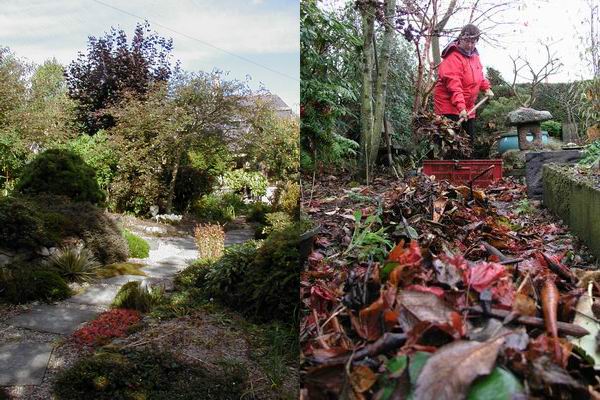
Gathering leaves Our main task of the moment is gathering leaves when ever the weather permits. On the left is the garden a few months back to show that we have quite a lot of deciduous trees (38 last count) for a town garden. The acers, birch and sorbus have all dropped their leaves now and the other species that we grow a selection of is cotoneaster. Some of these have lost their leaves and the others will drop gradually, depending on how cold it gets, until all the leaves are shed by mid to late February. The cotoneasters also provide lots of berries that ripen through the winter attracting many birds like waxwings, redwings and fieldfares into our garden. So what has this got to do with bulbs? Well, after the leaves are gathered we build them into a big heap in the compost corner where they rot down to produce leaf mould for next years repotting mixture. I am often asked how long it takes to produce leaf mould - we will be able to use the leaves we are collecting now next July. The secret of quick leaf mould is to ignore a lot of the advice that you read in many garden books and magazines where they tell you:- A) to place the leaves in black plastic bags {- this will produce a smelly sludge if they are too wet or if they are too dry nothing will happen at all.} B) Build a heap contained by chicken wire so the air can get in {- all you are likely to get with this method is a neat pile of dry leaves.} 
Leaves in heap Our method is to let the leaves get good and wet before you collect them and then we always build our heap adjacent to and touching the old heap - this allows free passage of the organisms that speed up the composting process. The heap is contained with brick or wooden sides and it is separated from the old heap by weld mesh. I compact the heap by standing on it then on top of the heap I place a weld mesh panel that is weighed down with bricks.(above right) Leaf mould The results are that we are fully self-sufficient in leaf mould for both potting compost and for top dressing some of the beds. 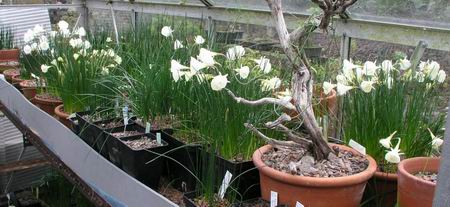
Bulb house The narcissus are looking good just now, it is mostly forms of romieuxii and cantabricus that are fully out. 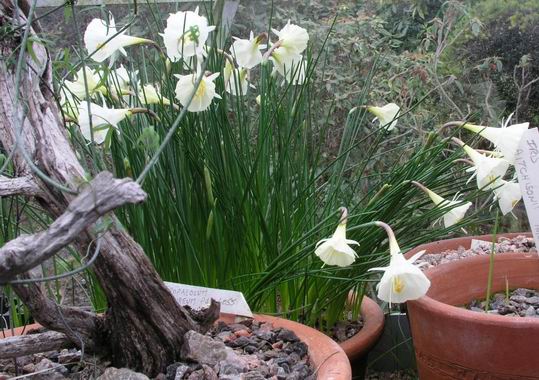
Narcissus water When you see the flowering stems start to flop over like this it is usually a sign that they need a good soaking - it is best to let them get to that stage of dryness between waterings. I prefer to water on a dry bright frost free day when the surplus water on the gravel can dry off , not a wet misty day when everything in the bulb house is hanging with moisture. We also use fans to move the air around both after watering on the wet days to help minimise the chance of fungal attack. 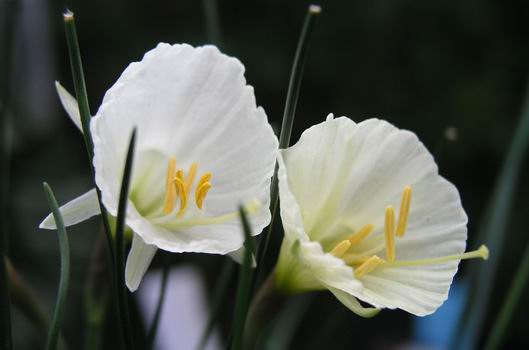
Narcissus romieuxii opening It is interesting to note that many of the N. romieuxii forms have a distinctly cream/yellow colour which quickly fades to white when the flower has fully expanded. 
Ripe pollen Also notice in this close up that the pollen is ripe and flowing - now is the time to use the paint brush and fertilise your plants to ensure a good seed set. You could also try your hand at making a cross by placing the pollen onto the stigma of another species - I will return to this in the next log. 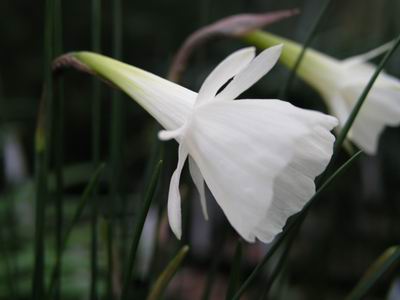
Narcissus cantibricus One of the other species that is in flower just now is Narcissus cantabricus which looks superficially similar to romieuxii until you look carefully at the flowers. 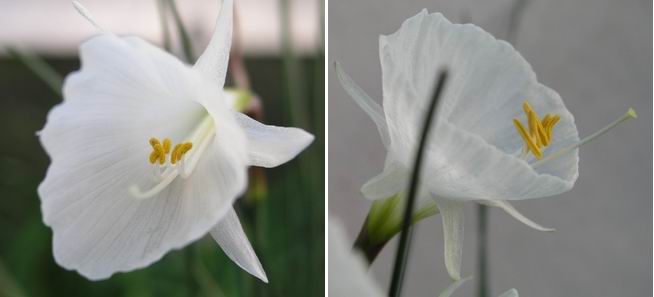
Narcissus cantabricus & romieuxii On the left is cantabricus with romieuxii to the right. You will notice that the stamens of romieuxii extend to and beyond the end of the flower whereas they only come about half way up the corona of cantabricus, this is the most obvious difference. The other noticeable difference that is not normally mentioned is that N. cantabricus has a beautiful sweet scent and romieuxii has almost no discernible scent. I showed Henry and Margaret Taylor's cross between N. cantabricus monophyllus and N. romieuxii : N.'Camoro', a few logs back, incidentally the name is made up of the first two letters of the two species involved. If you look you will see that the flowers are intermediate between the parents in that the anthers do not come out quite as far as the end of the trumpet but they come out further than you would expect in N. cantabricus, this lovely hybrid has also inherited the sweet scent from N. cantabricus. 
Narcissus 'Camoro' ^ back to the top ^ |